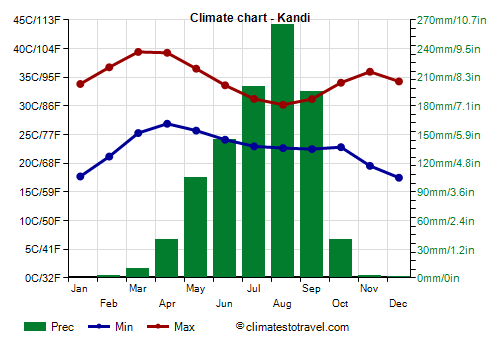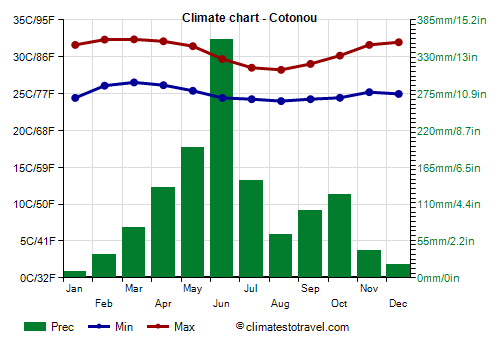Select units of measurement for the temperature and rainfall tables (metric or imperial).
Average weather, temperature, rainfall, sunshine
The climate in Benin, a small African country overlooking the Gulf of Guinea, is
tropical, with a dry season in winter and a rainy season due to the African monsoon, which runs from May to September in the extreme north and from mid-March to October in the south. Along the coast, there's a pause in the rainy season in August.
Precipitation is below 1,000 millimeters (40 inches) per annum in the extreme north, where the dry season lasts nearly seven months, while in the rest of the country, it ranges between 1,000 and 1,300 mm (40 and 51 in).
The climate in detail
The seasons
Winter, from November to January, is hot: it's often scorching in the north, where highs can exceed 35 °C (95 °F), while it's less hot along the coast, where highs are around 31/32 °C (88/90 °F), but it's also more humid and with a bit of cloudiness in the morning.
In the center and north, a wind from the desert blows in winter, called
Harmattan, which can fill the sky with dust, making it whitish and creating a peculiar mist in the early hours of the day. Moreover, in the north, nights are cool, and the temperature can drop to 13/15 °C (55/59 °F); in the past decades, in the far north the temperature has reached as low as 10 °C (50 °F).
From February to May, the temperature increases further in the north, often reaching 40 °C (104 °F). In the extreme north, the
W National Park, where the temperature can reach 45 °C (113 °F), is particularly hot; the
Pendjari National Park is very hot as well, here, however, the rains arrive a few weeks earlier, bringing a bit of relief.

The
first showers begin in March in the far south, and gradually move from the ocean to the north. In the north-central inland areas, the wettest period is from July to September; in these months, the daytime temperature remains around 28/29 °C (82/84 °F) along the coast and around 30/32 °C (86/90 °F) in the north, but relative humidity is high and cloud cover is frequent.
The rains cease in early October in the extreme north, and gradually recede towards the south; on the coast, they cease about a month later. With the return of the warm northeast winds, the temperature rises again, while the air returns to be dry in inland areas.
The cities
Kandi

In
Kandi, located in the north, at an altitude of 300 meters (985 feet), the maximum temperatures exceed 39 °C (102 °F) in March and April, while they drop to 30 °C (86 °F) in August.
As mentioned, in the north the rainiest period is shorter. In Kandi, 1,000 mm (40 in) of rain fall per year, of which more than 100 mm (4 in) per month from May to September.
In the north, the sun shines very often in the long dry period, from October to April, but there are numerous sunny periods even in the rainy season. However, the least sunny month is the wettest, namely August.
Cotonou

On the coast, the temperatures are more stable than in inland areas, however, here too, the coolest months are actually those of the summer, when the prevailing currents come from the sea. In
Cotonou, the largest city, located on the coast, not far from Porto-Novo, highs reach around 32.5 °C (90.5 °F) in March, while they drop to 28 °C (82.5 °F) in August.
As mentioned, on the coast the rains are more abundant and the rainy period is longer, however, the rainy season knows a break from mid-July to the end of August.
Along the coast, the
sun shines quite often in the dry season, however, a bit of cloudiness can form even in this period. In the rainy season, the sun shines quite rarely, even during the August break.
The temperature of the
sea is high throughout the year, although it is a bit warmer in the winter months.
In the capital,
Porto-Novo, near the eastern part of the coast, the wettest month is by far June, with more than 300 mm (12 in) of rain, then, from mid-July to late August, the rains decrease (while cloudiness remains widespread), while they rise again in September and October but without excesses, to around 140/150 mm (5.5/6 in) per month.
When to go
The best time to visit Benin is from
November to January: the air is dry and the weather is usually good. It is true that it's hot during the day, especially in the north, but less so than in the following period, from February to May.
The rainiest and sultriest months are May and June on the coast, while they are July, August and September in the center-north.
What to pack
In
winter: in Cotonou and the coast, bring light clothes for the day, a light sweatshirt for the evening, and a light scarf for the wind-borne sand and dust. In the north, bring light clothing, a sweatshirt and a light jacket for the evening, and a scarf for the desert wind. For women it's best to avoid shorts and miniskirts.
In
summer: bring light clothing of natural fibers, a light sweater and a light raincoat for the rain showers.
For women, it's best to avoid shorts and miniskirts.
Climate data - Benin
| Bohicon |
|---|
|
| Jan | Feb | Mar | Apr | May | Jun | Jul | Aug | Sep | Oct | Nov | Dec |
|---|
| Min temp. | 23 | 25 | 25 | 25 | 24 | 23 | 23 | 22 | 23 | 23 | 24 | 23 |
|---|
| Max temp. | 35 | 36 | 36 | 34 | 33 | 31 | 30 | 29 | 31 | 32 | 34 | 35 |
|---|
| Precip. | 5 | 30 | 75 | 125 | 155 | 175 | 140 | 110 | 140 | 120 | 20 | 15 |
|---|
| Prec. days | 1 | 2 | 5 | 9 | 10 | 12 | 9 | 8 | 9 | 9 | 2 | 1 |
|---|
| Humidity | 61% | 67% | 72% | 77% | 81% | 84% | 85% | 84% | 85% | 83% | 77% | 68% |
|---|
| Day length | 12 | 12 | 12 | 12 | 12 | 12 | 12 | 12 | 12 | 12 | 12 | 12 |
|---|
| Sun hours | 7 | 7 | 7 | 7 | 7 | 6 | 4 | 3 | 4 | 6 | 8 | 7 |
|---|
|
| Cotonou |
|---|
|
| Jan | Feb | Mar | Apr | May | Jun | Jul | Aug | Sep | Oct | Nov | Dec |
|---|
| Min temp. | 24 | 26 | 27 | 26 | 25 | 24 | 24 | 24 | 24 | 24 | 25 | 25 |
|---|
| Max temp. | 32 | 32 | 32 | 32 | 31 | 30 | 29 | 28 | 29 | 30 | 32 | 32 |
|---|
| Precip. | 10 | 35 | 75 | 135 | 195 | 355 | 145 | 65 | 100 | 125 | 40 | 20 |
|---|
| Prec. days | 1 | 2 | 4 | 7 | 11 | 15 | 8 | 5 | 8 | 8 | 4 | 2 |
|---|
| Humidity | 78% | 80% | 80% | 81% | 82% | 85% | 87% | 87% | 87% | 85% | 82% | 80% |
|---|
| Day length | 12 | 12 | 12 | 12 | 12 | 12 | 12 | 12 | 12 | 12 | 12 | 12 |
|---|
| Sun hours | 7 | 7 | 7 | 7 | 7 | 5 | 4 | 5 | 6 | 7 | 8 | 7 |
|---|
| Sea temp | 28 | 28 | 29 | 29 | 29 | 28 | 26 | 25 | 26 | 28 | 29 | 28 |
|---|
| Kandi (300 meters) |
|---|
|
| Jan | Feb | Mar | Apr | May | Jun | Jul | Aug | Sep | Oct | Nov | Dec |
|---|
| Min temp. | 18 | 21 | 25 | 27 | 26 | 24 | 23 | 23 | 22 | 23 | 20 | 17 |
|---|
| Max temp. | 34 | 37 | 39 | 39 | 36 | 34 | 31 | 30 | 31 | 34 | 36 | 34 |
|---|
| Precip. | 0 | 0 | 10 | 40 | 105 | 145 | 200 | 265 | 195 | 40 | 0 | 0 |
|---|
| Prec. days | 0 | 0 | 1 | 3 | 8 | 10 | 14 | 17 | 14 | 4 | 0 | 0 |
|---|
| Humidity | 26% | 24% | 28% | 44% | 61% | 71% | 79% | 83% | 82% | 72% | 42% | 30% |
|---|
| Day length | 12 | 12 | 12 | 12 | 13 | 13 | 13 | 12 | 12 | 12 | 12 | 12 |
|---|
| Sun hours | 10 | 10 | 9 | 9 | 9 | 9 | 8 | 6 | 7 | 9 | 10 | 10 |
|---|
|
| Natitingou (450 meters) |
|---|
|
| Jan | Feb | Mar | Apr | May | Jun | Jul | Aug | Sep | Oct | Nov | Dec |
|---|
| Min temp. | 18 | 21 | 24 | 25 | 24 | 23 | 22 | 22 | 21 | 21 | 19 | 18 |
|---|
| Max temp. | 35 | 37 | 38 | 36 | 34 | 32 | 30 | 29 | 31 | 33 | 35 | 35 |
|---|
| Precip. | 0 | 0 | 25 | 90 | 110 | 140 | 225 | 265 | 255 | 105 | 10 | 5 |
|---|
| Prec. days | 0 | 0 | 3 | 6 | 9 | 11 | 14 | 18 | 18 | 9 | 1 | 0 |
|---|
| Humidity | 33% | 35% | 47% | 62% | 72% | 79% | 84% | 85% | 85% | 78% | 56% | 40% |
|---|
| Day length | 12 | 12 | 12 | 12 | 13 | 13 | 13 | 12 | 12 | 12 | 12 | 12 |
|---|
| Sun hours | 9 | 9 | 8 | 8 | 8 | 7 | 5 | 4 | 5 | 7 | 9 | 8 |
|---|
|
| Parakou (380 meters) |
|---|
|
| Jan | Feb | Mar | Apr | May | Jun | Jul | Aug | Sep | Oct | Nov | Dec |
|---|
| Min temp. | 20 | 23 | 24 | 24 | 23 | 22 | 22 | 22 | 22 | 22 | 21 | 20 |
|---|
| Max temp. | 35 | 37 | 37 | 36 | 33 | 31 | 29 | 29 | 30 | 32 | 34 | 35 |
|---|
| Precip. | 5 | 10 | 40 | 85 | 130 | 170 | 190 | 210 | 205 | 90 | 5 | 5 |
|---|
| Prec. days | 0 | 1 | 3 | 5 | 9 | 11 | 12 | 13 | 15 | 7 | 1 | 1 |
|---|
| Humidity | 28% | 32% | 48% | 62% | 72% | 77% | 82% | 84% | 82% | 77% | 55% | 35% |
|---|
| Day length | 12 | 12 | 12 | 12 | 13 | 13 | 13 | 12 | 12 | 12 | 12 | 12 |
|---|
|
|
| Savè (200 meters) |
|---|
|
| Jan | Feb | Mar | Apr | May | Jun | Jul | Aug | Sep | Oct | Nov | Dec |
|---|
| Min temp. | 22 | 24 | 24 | 24 | 24 | 23 | 22 | 22 | 22 | 22 | 23 | 22 |
|---|
| Max temp. | 36 | 37 | 37 | 35 | 34 | 32 | 30 | 29 | 30 | 32 | 34 | 35 |
|---|
| Precip. | 5 | 20 | 70 | 110 | 130 | 150 | 160 | 125 | 155 | 115 | 20 | 5 |
|---|
| Prec. days | 0 | 1 | 4 | 5 | 6 | 9 | 12 | 12 | 12 | 7 | 2 | 1 |
|---|
| Humidity | 47% | 52% | 62% | 70% | 75% | 80% | 82% | 84% | 83% | 80% | 69% | 54% |
|---|
| Day length | 12 | 12 | 12 | 12 | 12 | 13 | 12 | 12 | 12 | 12 | 12 | 12 |
|---|
|
|
See also the
temperatures month by month